Redox Profiling of Selected Apulian Red Wines in a Single Minute
Abstract
:1. Introduction
2. Materials and Methods
2.1. Samples and Electrolytes
2.2. Selection of the Commonly Reported Antioxidants in Red Wine
2.3. Energy Refinement by MM2 and AMBER
2.4. Extended Hückel Method (EHM) and Determination of Molecular Orbital Energies
2.5. Electrochemical Measurements
2.6. Statistical Analysis
3. Results
4. Discussion
5. Conclusions
Author Contributions
Funding
Data Availability Statement
Conflicts of Interest
References
- Khalafyan, A.A.; Temerdashev, Z.A.; Kaunova, A.A.; Abakumov, A.; Titarenko, V.O.; Akin’Shina, V.A.; Ivanovets, E.A. Determination of the Wine Variety and Geographical Origin of White Wines Using Neural Network Technologies. J. Anal. Chem. 2019, 74, 617–624. [Google Scholar] [CrossRef]
- Moreira, L.K.D.S.; Silva, R.R.; da Silva, D.M.; Mendes, M.A.S.; de Brito, A.F.; de Carvalho, F.S.; Sanz, G.; Rodrigues, M.F.; da Silva, A.C.G.; Thomaz, D.V.; et al. Anxiolytic- and antidepressant-like effects of new phenylpiperazine derivative LQFM005 and its hydroxylated metabolite in mice. Behav. Brain Res. 2021, 417, 113582. [Google Scholar] [CrossRef] [PubMed]
- Dede, D.; Didaskalou, E.; Bersimis, S.; Georgakellos, D. A Statistical Framework for Assessing Environmental Performance of Quality Wine Production. Sustainability 2020, 12, 10246. [Google Scholar] [CrossRef]
- Canuti, V.; Cantu, A.; Picchi, M.; Lerno, L.A.; Tanabe, C.K.; Zanoni, B.; Heymann, H.; Ebeler, S.E. Evaluation of the Intrinsic and Perceived Quality of Sangiovese Wines from California and Italy. Foods 2020, 9, 1088. [Google Scholar] [CrossRef] [PubMed]
- Zurowietz, A.; Lehr, P.P.; Kleb, M.; Merkt, N.; Gödde, V.; Bednarz, H.; Niehaus, K.; Zörb, C. Training grapevines generates a metabolomic signature of wine. Food Chem. 2021, 368, 130665. [Google Scholar] [CrossRef]
- Fernandes, I.; Pérez-Gregorio, R.; Soares, S.; Mateus, N.; De Freitas, V.; Santos-Buelga, C.; Feliciano, A.S. Wine flavonoids in health and disease prevention. Molecules 2017, 22, 292. [Google Scholar] [CrossRef]
- Kumar, S.; Bajwa, J.; Magotra, S.; Koul, A. Therapeutic properties of wine: A review. Ann. Trop. Med. Public Health 2020, 23, 231–552. [Google Scholar] [CrossRef]
- Chidi, B.S.; Bauer, F.F.; Rossouw, D. Organic Acid Metabolism and the Impact of Fermentation Practices on Wine Acidity: A Review. S. Afr. J. Enol. Vitic. 2018, 39, 1–15. [Google Scholar] [CrossRef] [Green Version]
- Kennedy, J.A. Grape and wine phenolics: Observations and recent findings. Cienc. Investig. Agrar. 2008, 35, 107–120. [Google Scholar] [CrossRef]
- Ma, L.; Watrelot, A.A.; Addison, B.; Waterhouse, A.L. Condensed Tannin Reacts with SO2 during Wine Aging, Yielding Flavan-3-ol Sulfonates. J. Agric. Food Chem. 2018, 66, 9259–9268. [Google Scholar] [CrossRef]
- Ramos-Pineda, A.M.; García-Estévez, I.; Dueñas, M.; Escribano-Bailón, M.T. Effect of the addition of mannoproteins on the interaction between wine flavonols and salivary proteins. Food Chem. 2018, 264, 226–232. [Google Scholar] [CrossRef] [PubMed]
- Favre, G.; González-Neves, G.; Piccardo, D.; Gómez-Alonso, S.; Pérez-Navarro, J.; Hermosín-Gutiérrez, I. New acylated flavonols identified in Vitis vinifera grapes and wines. Food Res. Int. 2018, 112, 98–107. [Google Scholar] [CrossRef] [PubMed]
- He, F.; Liang, N.-N.; Mu, L.; Pan, Q.-H.; Wang, J.; Reeves, M.J.; Duan, C.-Q. Anthocyanins and Their Variation in Red Wines I. Monomeric Anthocyanins and Their Color Expression. Molecules 2012, 17, 1571–1601. [Google Scholar] [CrossRef] [PubMed] [Green Version]
- Benbouguerra, N.; Hornedo-Ortega, R.; Garcia, F.; El Khawand, T.; Saucier, C.; Richard, T. Stilbenes in grape berries and wine and their potential role as anti-obesity agents: A review. Trends Food Sci. Technol. 2021, 112, 362–381. [Google Scholar] [CrossRef]
- Mudnic, I.; Modun, D.; Rastija, V.; Vukovic, J.; Brizic, I.; Katalinic, V.; Kozina, B.; Medic-Saric, M.; Boban, M. Antioxidative and vasodilatory effects of phenolic acids in wine. Food Chem. 2010, 119, 1205–1210. [Google Scholar] [CrossRef]
- Isola, G. The impact of det, nutrition and nutraceuticals on oral and periodontal health. Nutrients 2020, 12, 2724. [Google Scholar] [CrossRef] [PubMed]
- Esteban-Fernández, A.; Zorraquín-Peña, I.; Ferrer, M.D.; Mira, A.; Bartolomé, B.; De Llano, D.G.; Moreno-Arribas, M.V. Inhibition of Oral Pathogens Adhesion to Human Gingival Fibroblasts by Wine Polyphenols Alone and in Combination with an Oral Probiotic. J. Agric. Food Chem. 2018, 66, 2071–2082. [Google Scholar] [CrossRef] [PubMed]
- Nazir, M.; Al-Ansari, A.; Al-Khalifa, K.; Alhareky, M.; Gaffar, B.; Almas, K. Global Prevalence of Periodontal Disease and Lack of Its Surveillance. Sci. World J. 2020, 2020, 2146160. [Google Scholar] [CrossRef]
- Wagner, M.C.; Cavagni, J.; Gaio, E.J.; Brum, V.S.; Jesus, L.H.; Filho, M.S.; Carrard, V.C.; Dorneles, G.P.; Peres, A.; Rösing, C.K. Effect of red wine and its major components on periodontitis and systemic inflammation in rats. J. Int. Acad. Periodontol. 2019, 21, 139–147. [Google Scholar]
- Dal-Fabbro, R.; Cosme-Silva, L.; de Oliveira, F.R.S.M.; Capalbo, L.C.; Plazza, F.A.; Ervolino, E.; Cintra, L.T.A.; Gomes-Filho, J.E. Effect of red wine or its polyphenols on induced apical periodontitis in rats. Int. Endod. J. 2021, 54, 2276–2289. [Google Scholar] [CrossRef]
- He, Z.; Zhang, X.; Song, Z.; Li, L.; Chang, H.; Li, S.; Zhou, W. Quercetin inhibits virulence properties of Porphyromas gingivalis in periodontal disease. Sci. Rep. 2020, 10, 18313. [Google Scholar] [CrossRef] [PubMed]
- Kugaji, M.S.; Kumbar, V.M.; Peram, M.R.; Patil, S.; Bhat, K.G.; Diwan, P.V. Effect of Resveratrol on biofilm formation and virulence factor gene expression ofPorphyromonas gingivalisin periodontal disease. APMIS 2019, 127, 187–195. [Google Scholar] [CrossRef] [PubMed]
- Lim, Y.R.I.; Preshaw, P.M.; Lin, H.; Tan, K.S. Resveratrol and Its Analogs as Functional Foods in Periodontal Disease Management. Front. Dent. Med. 2021, 2, 636423. [Google Scholar] [CrossRef]
- Nitiéma, M.; Koala, M.; Belemnaba, L.; Ouédraogo, J.C.W.; Ouédraogo, S.; Kini, F.B.; Ouédraogo, S.; Guissou, I.P. Endothelium-Independent Vasorelaxant Effects of Anthocyanins-Enriched Extract from Odontonema strictum (Nees) Kuntze (Acanthaceae) Flowers: Ca2+ Channels Involvement. Eur. J. Med. Plants 2019, 29, 1–11. [Google Scholar] [CrossRef] [Green Version]
- Lapidot, T.; Harel, S.; Granit, R.; Kanner, J. Bioavailability of Red Wine Anthocyanins as Detected in Human Urine. J. Agric. Food Chem. 1998, 46, 4297–4302. [Google Scholar] [CrossRef]
- De Filippis, B.; Ammazzalorso, A.; Fantacuzzi, M.; Giampietro, L.; Maccallini, C.; Amoroso, R. Anticancer Activity of Stilbene-Based Derivatives. ChemMedChem 2017, 12, 558–570. [Google Scholar] [CrossRef]
- Saenz-Navajas, M.-P.; Ferrero-Del-Teso, S.; Romero, M.; Pascual, D.; Diaz, D.; Ferreira, V.; Fernández-Zurbano, P. Modelling wine astringency from its chemical composition using machine learning algorithms. OENO One 2019, 53, 499–509. [Google Scholar] [CrossRef]
- Leite, K.C.D.S.; Garcia, L.F.; Lobón, G.S.; Thomaz, D.V.; Moreno, E.K.G.; De Carvalho, M.F.; Rocha, M.L.; Dos Santos, W.T.P.; Gil, E.D.S. Antioxidant activity evaluation of dried herbal extracts: An electroanalytical approach. Rev. Bras. Farm. 2018, 28, 325–332. [Google Scholar] [CrossRef]
- Thomaz, D.V. Assessment of Noni (Morinda citrifolia L.) Product Authenticity by Solid State Voltammetry. Int. J. Electrochem. Sci. 2018, 2018, 8983–8994. [Google Scholar] [CrossRef]
- Thomaz, D.V. Thermodynamics and Kinetics of Camellia sinensis Extracts and Constituents: An Untamed Antioxidant Potential. In Bioactive Compounds in Nutraceutical and Functional Food for Good Human Health; IntechOpen: London, UK, 2021. [Google Scholar] [CrossRef]
- Alves, C.B.; Rodrigues, E.S.B.; Thomaz, D.V.; de Aguiar Filho, A.M.; de Souza Gil, E.; do Couto, R.O. Correlation of polyphenol content and antioxidant capacity of selected teas and tisanes from Brazilian market. Braz. J. Food Technol. 2020, 7, 5001–5012. [Google Scholar] [CrossRef]
- Barnaba, C.; Dellacassa, E.; Nicolini, G.; Nardin, T.; Malacarne, M.; Larcher, R. Free and glycosylated simple phenol profiling in Apulian Italian wines. Food Chem. 2016, 206, 260–266. [Google Scholar] [CrossRef] [PubMed]
- Capone, S.; Tufariello, M.; Siciliano, P. Analytical characterisation of Negroamaro red wines by “Aroma Wheels”. Food Chem. 2013, 141, 2906–2915. [Google Scholar] [CrossRef] [PubMed]
- Antonacci, G.; De Biase, G.; Milella, R.; Antonacci, D. Potere antiossidante di vini pugliesi. BIO Web Conf. 2019, 15, 04007. [Google Scholar] [CrossRef]
- Wozny, J.; Kovalchuk, A.; Podgorski, J.; Lisik, Z. Extended Hückel Semi-Empirical Approach as an Efficient Method for Structural Defects Analysis in 4H-SiC. Materials 2021, 14, 1247. [Google Scholar] [CrossRef] [PubMed]
- Halgren, T.A. The representation of van der Waals (vdW) interactions in molecular mechanics force fields: Potential form, combination rules, and vdW parameters. J. Am. Chem. Soc. 1992, 114, 7827–7843. [Google Scholar] [CrossRef]
- Case, D.A.; Cheatham, T.E., III; Darden, T.; Gohlke, H.; Luo, R.; Merz, K.M., Jr.; Onufriev, A.; Simmerling, C.; Wang, B.; Woods, R.J. The Amber biomolecular simulation programs. J. Comput. Chem. 2005, 26, 1668–1688. [Google Scholar] [CrossRef] [Green Version]
- Asanuma, M.; Aogaki, R. Nonequilibrium fluctuation theory on pitting dissolution. II. Determination of surface coverage of nickel passive film. J. Chem. Phys. 1997, 106, 9938–9943. [Google Scholar] [CrossRef]
- Bêlehrádek, J. Theoretical interpretation of the temperature-viscosity equation of slotte in connection with vitrification. Recueil des Travaux Chimiques des Pays-Bas 1957, 76, 165–168. [Google Scholar] [CrossRef]
- Ross, T. Bělehrádek-type models. J. Ind. Microbiol. Biotechnol. 1993, 12, 180–189. [Google Scholar] [CrossRef]
- Oliveira, T.S.; Thomaz, D.V.; Neri, H.F.D.S.; Cerqueira, L.B.; Garcia, L.F.; Gil, H.; Pontarolo, R.; Campos, F.R.; Costa, E.A.; dos Santos, F.C.A.; et al. Neuroprotective Effect of Caryocar brasiliense Camb. Leaves Is Associated with Anticholinesterase and Antioxidant Properties. Oxid. Med. Cell. Longev. 2018, 2018, 9842908. [Google Scholar] [CrossRef] [Green Version]
- Thomaz, D.V.; Peixoto, L.F.; de Oliveira, T.S.; Fajemiroye, J.O.; da Silva Neri, H.F.; Xavier, C.H.; Costa, E.A.; Alcantara dos Santos, F.C.; de Souza Gil, E.; Ghedini, P.C. Antioxidant and Neuroprotective Properties of Eugenia dysenterica Leaves. Oxid. Med. Cell. Longev. 2018, 2018, 3250908. [Google Scholar] [CrossRef] [PubMed] [Green Version]
- Moreno, E.K.G.; Thomaz, D.V.; Machado, F.B.; Leite, K.C.D.S.; Rodrigues, E.S.B.; Fernandes, M.A.; de Carvalho, M.F.; de Oliveira, M.T.; Caetano, M.P.; Peixoto, C.E.D.C.; et al. Antioxidant Study and Electroanalytical Investigation of Selected Herbal Samples Used in Folk Medicine. Int. J. Electrochem. Sci. 2019, 14, 838–847. [Google Scholar] [CrossRef]
- Thomaz, D.V.; dos Santos, P.A. Redox Behavior and Radical Scavenging Capacity of Hepatoprotective Nutraceutical Preparations. Curr. Nutraceuticals 2021, 2, 312–318. [Google Scholar] [CrossRef]
- Cassino, C.; Gianotti, V.; Bonello, F.; Tsolakis, C.; Cravero, M.C.; Osella, D. Antioxidant Composition of a Selection of Italian Red Wines and Their Corresponding Free-Radical Scavenging Ability. J. Chem. 2016, 2016, 4565391. [Google Scholar] [CrossRef]
- Chen, Y.; Xiao, H.; Zheng, J.; Liang, G. Structure-Thermodynamics-Antioxidant Activity Relationships of Selected Natural Phenolic Acids and Derivatives: An Experimental and Theoretical Evaluation. PLoS ONE 2015, 10, e0121276. [Google Scholar] [CrossRef] [PubMed]
- Kumar, J.; Kumar, N.; Sati, N.; Hota, P.K. Antioxidant properties of ethenyl indole: DPPH assay and TDDFT studies. New J. Chem. 2020, 44, 8960–8970. [Google Scholar] [CrossRef]
- Motin, M.A.; Uddin, M.A.; Dhar, P.K.; Mia, M.A.H.; Hashem, M.A. Study of Electrochemical Oxidation of Catechol in the Presence of Sulfanilic Acid at Different pH. Port. Electrochim. Acta 2017, 35, 103–116. [Google Scholar] [CrossRef]
- Marcano, E. DFT study of anthocyanidin and anthocyanin pigments for Dye-Sensitized Solar Cells: Electron injecting from the excited states and adsorption onto TiO2 (anatase) surface. Phys. Sci. Rev. 2017, 2, 29–38. [Google Scholar] [CrossRef]
- Kilmartin, P.A. Electrochemistry applied to the analysis of wine: A mini-review. Electrochem. Commun. 2016, 67, 39–42. [Google Scholar] [CrossRef]
- Thomaz, D.V.; De Oliveira, M.G.; Rodrigues, E.S.B.; Da Silva, V.B.; Dos Santos, P.A. Physicochemical Investigation of Psoralen Binding to Double Stranded DNA through Electroanalytical and Cheminformatic Approaches. Pharmaceuticals 2020, 13, 108. [Google Scholar] [CrossRef]
- Rodrigues, E.S.B.; de Macêdo, I.Y.L.; da Silva Lima, L.L.; Thomaz, D.V.; da Cunha, C.E.P.; Teles de Oliveira, M.; Ballaminut, N.; Alecrim, M.F.; Ferreira de Carvalho, M.; Isecke, B.G.; et al. Electrochemical Characterization of Central Action Tricyclic Drugs by Voltammetric Techniques and Density Functional Theory Calculations. Pharmaceuticals 2019, 12, 116. [Google Scholar] [CrossRef] [PubMed] [Green Version]
- Holtan, M.D.; Somasundaram, S.; Khuda, N.; Easley, C.J. Nonfaradaic Current Suppression in DNA-Based Electrochemical Assays with a Differential Potentiostat. Anal. Chem. 2019, 91, 15833–15839. [Google Scholar] [CrossRef] [PubMed]
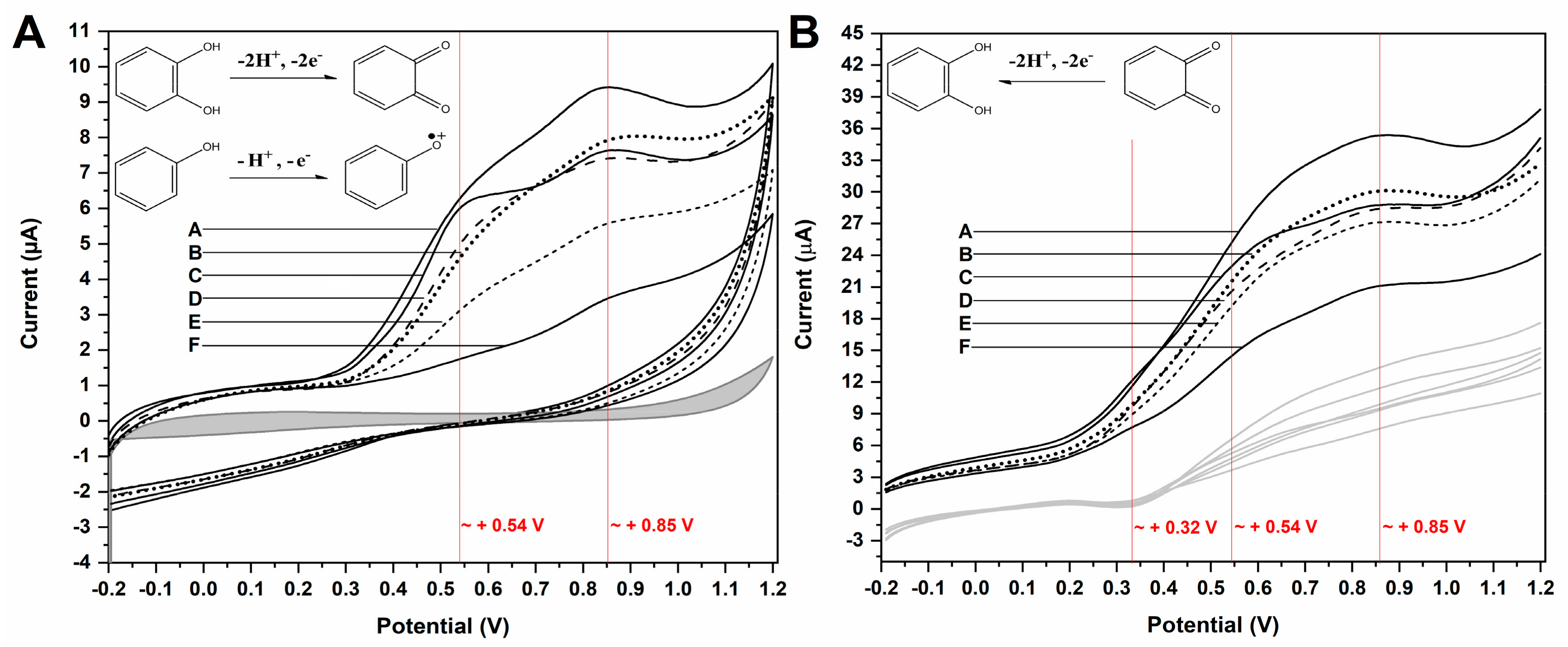
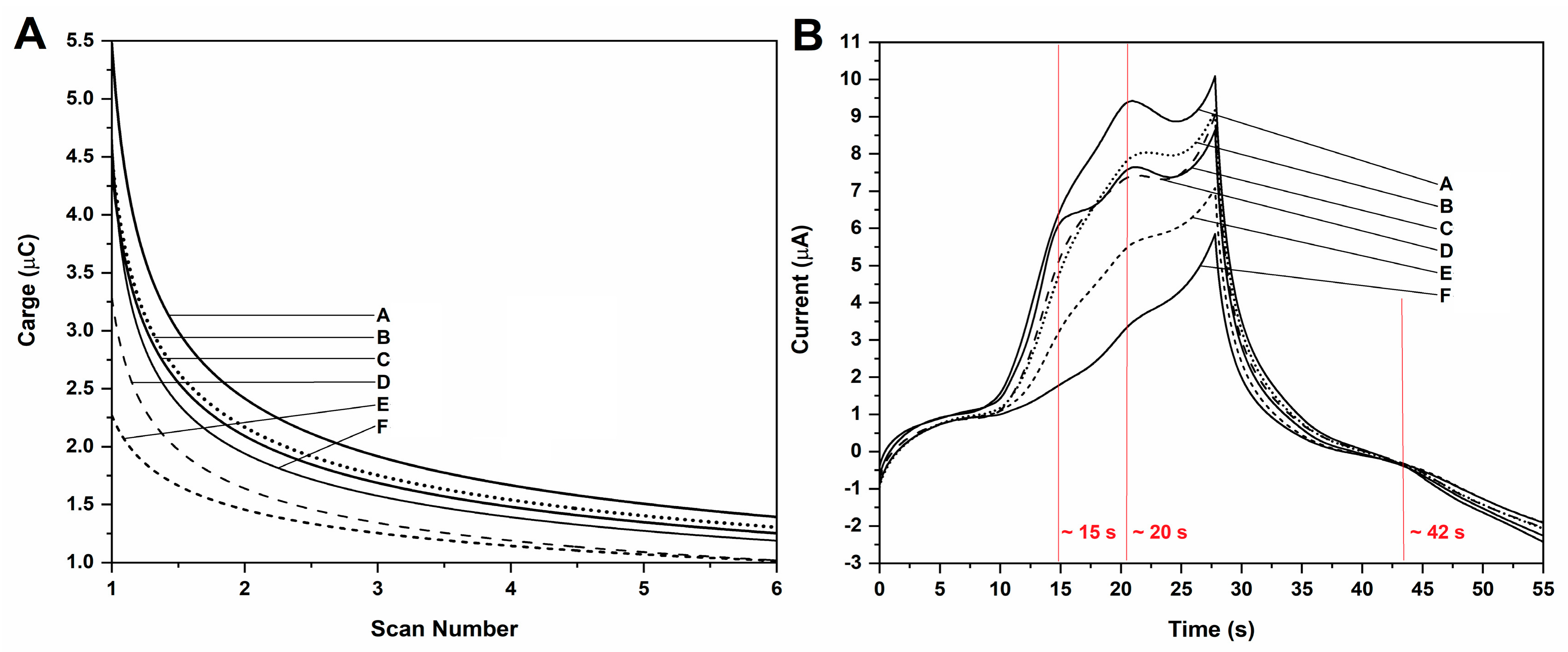
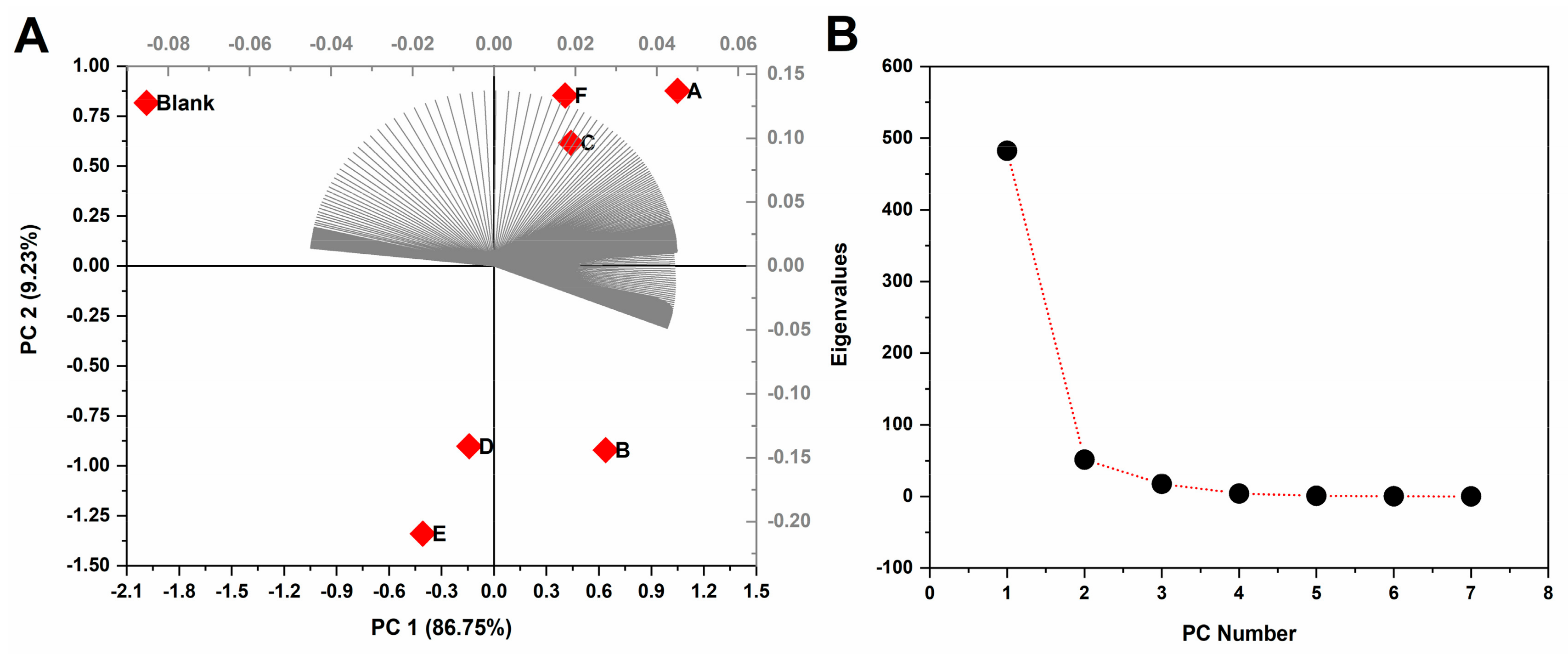
| Compound | Chemical Structure | HOMO Mapping | PubChemID |
|---|---|---|---|
| Catechin |  | 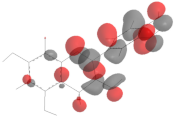 | 9064 |
| Quercetin |  |  | 5280343 |
| Cyanidin | 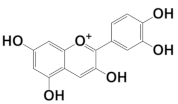 | 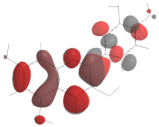 | 128861 |
| Resveratrol |  |  | 445154 |
| Gallic acid |  |  | 370 |
| Compound | HOMO (eV) | LUMO (eV) | ΔE (eV) |
|---|---|---|---|
| Catechin | −10.885 | 1.293 | 12.178 |
| Quercetin | −10.086 | −3.902 | 6.184 |
| Cyanidin | −3.965 | 0.887 | 4.852 |
| Resveratrol | −11.581 | −4.132 | 7.449 |
| Gallic acid | −11.026 | −3.01 | 8.016 |
Publisher’s Note: MDPI stays neutral with regard to jurisdictional claims in published maps and institutional affiliations. |
© 2022 by the authors. Licensee MDPI, Basel, Switzerland. This article is an open access article distributed under the terms and conditions of the Creative Commons Attribution (CC BY) license (https://creativecommons.org/licenses/by/4.0/).
Share and Cite
Thomaz, D.V.; do Couto, R.O.; Goldoni, R.; Malitesta, C.; Mazzotta, E.; Tartaglia, G.M. Redox Profiling of Selected Apulian Red Wines in a Single Minute. Antioxidants 2022, 11, 859. https://doi.org/10.3390/antiox11050859
Thomaz DV, do Couto RO, Goldoni R, Malitesta C, Mazzotta E, Tartaglia GM. Redox Profiling of Selected Apulian Red Wines in a Single Minute. Antioxidants. 2022; 11(5):859. https://doi.org/10.3390/antiox11050859
Chicago/Turabian StyleThomaz, Douglas Vieira, Renê Oliveira do Couto, Riccardo Goldoni, Cosimino Malitesta, Elisabetta Mazzotta, and Gianluca Martino Tartaglia. 2022. "Redox Profiling of Selected Apulian Red Wines in a Single Minute" Antioxidants 11, no. 5: 859. https://doi.org/10.3390/antiox11050859
APA StyleThomaz, D. V., do Couto, R. O., Goldoni, R., Malitesta, C., Mazzotta, E., & Tartaglia, G. M. (2022). Redox Profiling of Selected Apulian Red Wines in a Single Minute. Antioxidants, 11(5), 859. https://doi.org/10.3390/antiox11050859








